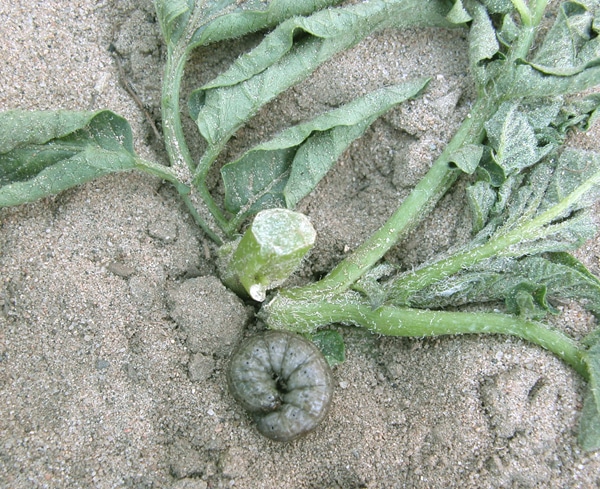Life Stages: Adult Moths – Eggs – Larvae – Pupa – Adult Moths
First Generation: May – June
Adult moths do not overwinter in Ontario but are blown up from the south on storm fronts. Consequently, black cutworm infestations are unpredictable. Damage varies from field to field and from year to year. This insect can cause considerable economic losses if not detected, so scouting is essential.
The adults are grey moths with black markings on the wings, including a dagger on the outer forewing that is distinctive. Like most moths, they are active primarily at night.
Larvae are greasy grey to black and look grainy. All stages curl up into a tight C-shape when disturbed. Small larvae feed on the leaves. It is the fourth and fifth larval stage, larvae that are longer than a half inch, that feed near the base of potato plants and cut off stems. Mature larvae grow to be 1.5 inches long and cause considerable damage.
Damage to potato crops early in the season is serious. The seed piece may send up another shoot, but the crop will be set back.
How to Scout for Black Cutworms in June
Walk fields shortly after plant emergence. Check 25 consecutive plants within a row in 10 sites of the field. You will be examining 250 plants, then calculate the percentage of affected plants; Always check low spots and weedy areas. The larvae may be found during the day by removing soil to a depth of five centimetres from around damaged plants.
Economic Threshold (ET): Five centimetres of the plants cut or wilted
Second Generation: Mid July – August
Usually a second generation attacks potatoes from mid-July to August. Pheromone traps should be used to monitor July flights of male moths. Hang the traps six to seven feet above the ground close to trees or shrubs surrounding the fields. Do not hang traps near lights that are on at night. Check the traps daily to determine if there were flights the previous night. Remove captured male moths daily from the traps, and change the sticky surfaces every two weeks.
A high number of male moths caught in traps indicates that the moths are mating and that the females are laying eggs. Growers have 10 to 12 days to apply an insecticide to control small larvae.
Economic Thresholds for the Second Generation of Black cutworm Pheromone Traps
Moderate to high potential for cutworm outbreaks: Catches of nine to 15 moths in a seen day period
High potential for cutworm damage: Moth catches of five per night for at least two consecutive nights
An insecticide spray is recommended no later than 10 days after peak moth activity
You can expect to see tuber damage around 300 degree-days (base of 50 F) from peak moth activity











